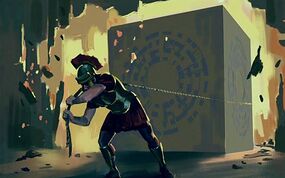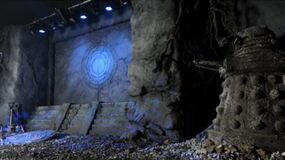Pandorica
The Pandorica was a prison hidden under Stonehenge. It was built to hold the Doctor and ensure the safety of the Alliance. Despite being described time and again as the "perfect prison" by the Eleventh Doctor, it also proved to be "easy" to open from the outside; Rory Williams, on instruction from the Doctor, opened it with the sonic screwdriver.
Design
The Pandorica looked like an image of Pandora's box on a book found in Amy Pond's bedroom. It was lined with a very ornate and complex set of security tumblers that glowed green when they were being unlocked, likening the Pandorica to a heavily vaulted safe. The interior was a small room with a chair in it and a set of manacles built into the arm rests. When someone was placed on the chair, the exterior would close and the manacles would lock around their wrists to shackle the person to the chair, sealing them in tightly. (TV: The Big Bang)
History
According to legend, the Pandorica was the prison of a warrior or goblin who dropped out of the sky and tore the world apart until a good wizard tricked it and locked it up.
The Pandorica was actually a prison built by the Alliance for the Doctor to stop him from inadvertently destroying all of creation in every Universe. They believed the Doctor would be responsible for the destruction of existence itself.
They used the lure of the Pandorica to trap him. There were many layers of security in the Pandorica including deadlocks, time stops and matter lines. It even had a restoration field to stop the Doctor from dying, which the Alliance believed a form of escape. (TV: The Pandorica Opens)
After the Alliance trapped the Doctor in the Pandorica in 102 AD, the Auton duplicate of Rory Williams succumbed to his programming and shot Amy Pond. (TV: The Pandorica Opens) However, a future version of the Doctor was able to go back in time using River Song's vortex manipulator and tell Rory how he could use the sonic screwdriver to release the Doctor, as well as use the Pandorica to save Amy by sealing the dying Amy inside the Pandorica. Rory then pledged himself to defending the Pandorica until Amy could be revived.
In 118, the Pandorica was taken back to Rome under armed guard. (TV: The Big Bang) Rory followed it to Rome where he was forced to fight as a gladiator, then the personal guard of the Caesar, (AUDIO: Gladiator) the assassin of his successor Augusta, and finally he became Emperor himself. (AUDIO: The Unwilling Assassin) Rory then abdicated, found the Pandorica, and made for Britannia with the box, via Ostia and France. (AUDIO: I, Rorius)
In 420, it was plundered by the Franks. By 1120, it was the prized possession of the Knights Templar.
In 1231, it was donated to the Vatican. Sometime after, it was sold by Marco Polo.

It was once put into storage in a London warehouse which was destroyed by the Blitz in 1941. It was reportedly seen being dragged to safety from the burning warehouse by the Last Centurion, and found a short distance away, unscathed.
It was finally opened in 1996, when Amy's younger self came to the museum where the Pandorica was kept. Young Amy's contact with the Pandorica gave it a sample of her DNA, which it could use as a sample to fully revive the nearly dead adult Amy.
The Pandorica was then used by the Doctor to reboot the universe. Since all of the traps inside it provided the perfect barrier against the destruction of the universe the Alliance had been trying to avoid, it retained several billion atoms of the original universe within, even after the destruction of the rest of creation. Operating on the same principle as cloning a body from a single cell, these atoms provided a "blueprint" for the universe when the Doctor piloted it into the exploding TARDIS which had cracked all of time and space. The atoms from the Pandorica combined with the energy of the TARDIS' explosion to restore every point in time and the universe. Doing so caused the cracks in time to close and allowed Amy to remember her family and the Doctor - all erased by the cracks - back into existence. (TV: The Big Bang)
Other references
As a "sneak preview", River mentioned to the Eleventh Doctor that he would see her again "quite soon. When the Pandorica opens." The Doctor responded that that was a fairy tale. (TV: Flesh and Stone) When Flemming was reading River's diary, he mentioned this adventure, remarking that it sounded "exciting". (TV: The Husbands of River Song)
As recorded by the Testimony, the "Imp of the Pandorica" was a name for the Doctor given his entrapment in the prison. (TV: Twice Upon a Time)
A prison similar to the Pandorica, made of dwarf star alloy to prevent anything from entering it, was built by the United States government inside Area 51 in 1969 with the official purpose of keeping inside it the Doctor, but was later revealed to be a place where he, River Song, Amy, Rory, Canton Everett Delaware III and President Richard Nixon could talk about Silents and operate the Doctor's TARDIS. (TV: Day of the Moon)
Behind the scenes
- For the Doctor Who Experience (London/Cardiff), part of the interactive story featured a device called the "Pandorica II". The Alliance trapped the Doctor in it again and it was up to the guests to bring the TARDIS to him, so he could escape. The Doctor considered the Back Up Pandorica as cheating and complained on the fact that it wasn't even a different colour.


